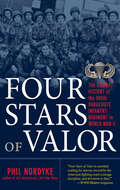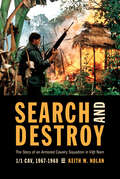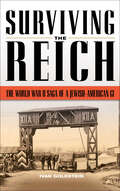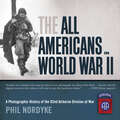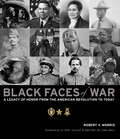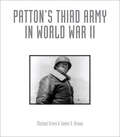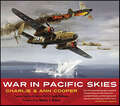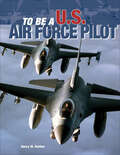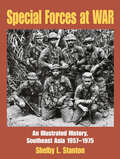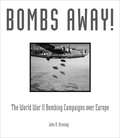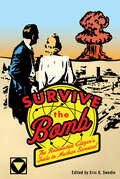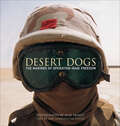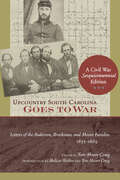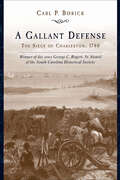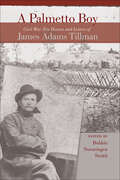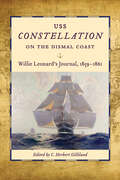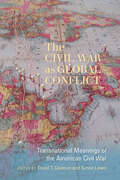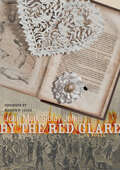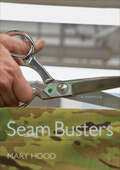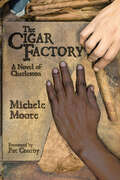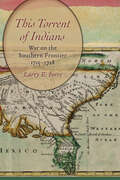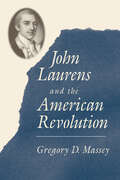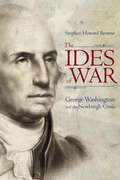- Table View
- List View
Four Stars of Valor: The Combat History of the 505th Parachute Infantry Regiment in World War II
by Phil NordykeHailing from the big cities and small towns of America, these young men came together to serve their country and the greater good. They were the 505th Parachute Infantry Regiment of the 82nd Airborne Division (the All Americans). Phil Nordyke, their official historian, draws on interviews with surviving veterans and oral history recordings as well as official archives and unpublished written accounts from more than three hundred veterans of the 505th PIR and their supporting units. This is history as it was lived by the men of the 505th, from their prewar coming of age in the regiment, through the end of World War II, when they marched in the Victory Parade up Fifth Avenue in New York, to the postwar legacy of having been part of an elite parachute regiment with a record unsurpassed in the annals of combat.
Search and Destroy: The Story of an Armored Cavalry Squadron in Viet Nam, 1/1 Cav, 1967–1968
by Keith W. NolanUsing firsthand accounts from Vietnam soldiers, this book “tells it like it is, warts and all . . . [an] honest account of a cavalry squadron’s experience” (Military Review).The 1st Squadron, 1st Cavalry Regiment, of the 1st Armored Division deployed to Vietnam from Fort Hood, Texas, in August 1967. Search and Destroy covers the 1/1’s harrowing first year and a half of combat in the war’s toughest area of operations: I Corps.The book takes readers into the savage action at infamous places like Tam Ky, the Que Son Valley, the Pineapple Forest, Hill 34, and Cigar Island, chronicling General Westmoreland’s search-and-destroy war of attrition against the Viet Cong and North Vietnamese Army. Exploring the gray areas of guerrilla war, military historian Keith Nolan details moments of great compassion toward the Vietnamese, but also eruptions of My Lai-like violence, the grimmer aspects of the 1/1’s successes. Search and Destroy is a rare account of an exemplary fighting force in action, a dramatic close-up look at the Vietnam War.“Nolan’s research, his comprehension of the political as well as the military actions, his careful concern for those who were there, and, most of all, his writing, are superb.” —Stephen Ambrose
Surviving the Reich: The World War II Saga of a Jewish-American GI
by Ivan GoldsteinThe memoirs of a Jewish-American soldier who is taken as a POW by the Germans and survives against all odds.Ivan Goldstein was a nineteen-year-old green-as-grass soldier heading into his first battle: the Battle of the Bulge, World War II’s fiercest engagement between the American army and Hitler’s army. A bow gunner on a Sherman tank, Private Goldstein was only hours into his first battle when his tank was hit by an enemy shell, and he was almost killed. Goldstein escapes with his life . . . only to be captured by the Germans. This could be the story of many young men from what has rightly been called “the Greatest Generation,” but Goldstein is not any young man. He is an American Jew. And when a German officer learns this, the officer says, “In the morning, take the Jew out and shoot him.” What follows is an epic story of survival in the face of seemingly insurmountable odds that is sure to engage everyone interested in the war against the Third Reich.
The All Americans in World War II: A Photographic History of the 82nd Airborne Division at War
by Phil NordykeOn the night of July 9/10, 1943 the All Americans of the 82nd Airborne Division jumped into history as they made their first parachute assault of World War II. Three others would follow: Salerno, Normandy, and Holland. In total the division served more than three hundred days in combat, a record unmatched by any other American division.With nearly four hundred historic photographs, many never before published, The All Americans in World War II provides a complete photographic history of the 82nd Airborne Division as it fought its way across Sicily, Italy, France, Belgium, and Germany, ultimately all the way to Berlin as part of the American occupation forces. This book is an essential addition to any serious World War II collection and a tribute to the fighting spirit of this legendary division.
Black Faces of War: A Legacy of Honor from the American Revolution to Today
by Robert V. MorrisThis commemoration of African-Americans in the U.S. military includes contributions from W. Stephen Morris and Luther H. Smith, one of the most-celebrated Tuskegee Airmen. Other black military heroes featured in the book include Crispus Attucks, the first man to die in the Revolutionary War; Lt. James Reese Europe, who brought jazz music to Europe in 1918; Lt. Charity Adams, commander of the only all-black Women's Army Corps unit during World War II; and Gen. Colin Powell, who served with distinction in Vietnam, became the first African-American Chairman of the Joint Chiefs of Staff during the Gulf War, and retired a four-star general before becoming the first African-American Secretary of State.
Patton's Third Army in World War II
by Michael Green James BrownPatton was champing at the bit to lead the D-Day invasion, but Eisenhower placed him in command of a decoy unit, the First U.S. Army Group. Nearly seven weeks after D-Day, Patton finally got his chance to take Third Army into battle. He began a ten-month rampage across France, driving through Germany and into Nazi-occupied Czechoslovakia and Austria. Along the way Third Army forces entered the Battle of the Bulge, breaking the siege of Bastogne. It was a turning point in the war, and afterward the Third Army pushed eastward again. Patton’s Third Army in World War II covers Patton’s command of Third Army with a focus on the armor. It was a new style of fighting, avoiding entrenched infantry warfare by continuously pushing forward, and it appealed to Patton’s hard-charging personality. Archival photos along with frequent quotes complete the portrait of Patton as well as his men as they fight their way across the Third Reich.
War in Pacific Skies
by Charlie Cooper Ann CooperPaintings by the renowned aviation artist plus “lots of wartime photographs and plenty of entertaining and informative text. . . . absorbing reading” (Aviation History).Climb in to the cockpit of some of America’s most heralded warbirds, like the P-38 that carried Richard Bong to his forty kills, and fly along with Paul Tibitts in the Enola Gay as it makes its final approach on Hiroshima. This lavishly illustrated book covers the most famous air engagements in World War II’s Pacific Theater of Operation in an exquisite and beautiful fusion of art and history. Paintings by acclaimed aviation artist Jack Fellows are supplemented by color maps, previously unpublished photographs, original artwork, and personal accounts.
To Be a U.S. Air Force Pilot (To Be A)
by Henry M. HoldenA comprehensive look into what it takes to make a pilot in the United States Air Force.To Be a U.S. Air Force Pilot details every step of training for those with the skill and daring to “cross into the blue” as an elite US Air Force pilot. The book traces the growth of aspiring young recruits, starting with grueling physical and mental tests, early flight training on high-tech flight simulators, moving onward and upward until they are finally ready to push the outer envelope to Mach II in state-of-the-art fighter aircraft.Thanks to the highly motivated, highly skilled, and dedicated men and women of the United States Air Force, America enters the uncertain landscape of the twenty-first century with the most powerful, swift, and flexible military force the world has ever seen.
Special Forces at War: An Illustrated History, Southeast Asia 1957–1975
by Shelby L. Stanton“A rare insider’s experience paired with a scholarly historical approach, making it an essential standout for any military library.” —Midwest Book ReviewMore than 8.7 million Americans reported for military duty in Southeast Asia, but only a select few wore the Green Beret, the distinctive symbol of the U.S. Army Special Forces. These elite soldiers played a crucial role during the protracted conflict.Special Forces at War: an Illustrated History, Southeast Asia 1957–1975 by wartime veteran and military historian Shelby L. Stanton shows Special Forces’ activity from the first deployments of Green Berets into battle, through their training, wartime advisory, border surveillance, strike force, and special operations roles.Unprecedented in scope, this photographic history features rare and unpublished images, providing an exclusive, insider view of covert activities such as Project Delta, whose Special Forces-trained Vietnamese commandos posed as North Vietnamese Army or Viet Cong troops behind communist lines. It depicts Special Forces’ camps before, during, and after enemy assaults. It features an array of lethal weapons used by resourceful Green Berets fighting to preserve their remote outposts, as well as allied and enemy documents and propaganda. From ordinary camp life to special missions, no aspect of Special Forces activities during the Second Indochina War has been overlooked.Stanton knows his subject first hand. During six years of active duty as an infantry officer in the U.S. Army, he served as a paratrooper platoon leader, an airborne ranger advisor to the Royal Thai Army Special Warfare Center, and a Special Forces long-range reconnaissance team commander in Southeast Asia before being wounded in combat in Nam Yu, Laos.
Bombs Away!: The World War II Bombing Campaigns over Europe
by John R. BruningBombs Away! covers strategic bombing in Europe during World War II, that is, all aerial bombardment of a strategic nature which took place between 1939 and 1945. In addition to American (U.S. Army Air Forces) and British (RAF Bomber Command) strategic aerial campaigns against Germany, this book covers German use of strategic bombing during the Nazi’s conquest of Europe: the Battle of Britain, Operation Barbarossa, and the V 1 and V 2, where the Luftwaffe targeted Warsaw and Rotterdam (known as the Rotterdam Blitz). In addition, the book covers the blitzes against London and the bombing of other British industrial and port cities, such as Birmingham, Liverpool, Southampton, Manchester, Bristol, Belfast, Cardiff, and Coventry bombed during the Battle of Britain. The twin Allied campaigns against Germany—the USAAF by day, the RAF by night—built up into massive bombing of German industrial areas, notably the Ruhr, followed by attacks directly on cities such as Hamburg, Kassel, Pforzheim, Mainz, Cologne, Bremen, Essen, Düsseldorf, Hanover, Dortmund, Frankfurt, and the still controversial fire-bombing of Hamburg and Dresden. In addition to obvious targets like aircraft and tank manufacturers, ball bearing factories and plants that manufactured abrasives and grinding wheels were high priority targets. Petroleum refineries were a key target with USAAF aircraft based in North Africa and later Italy, bombing the massive refinery complexes in and around Ploesti, Romania, until August 1944 when the Soviet Red Army captured the area. Other missions included industrial targets in southern Germany like Regensburg and Schweinfurt. Missions to the Nazi capital, Berlin, started in 1940 and continued through March 1945. Throughout the war there were 314 air raids on Berlin. All of this is covered in detail with authoritative text and hundreds of archival photographs, many rare or never before published.
Grumman F-14 Tomcat: Bye-Bye Baby. . . !
by Dave Parsons George Hall Bob LawsonFor thirty-five years of active naval service, the Grumman F-14 Tomcat was the foremost air superiority fighter of the Cold War, with continuing service as a fighter-bomber in the Gulf Wars. Two hundred thousand sailors, both pilots and "ground" crew, served in F-14 squadrons with the Tomcat over its decades of flight.This book is a grand remembrance of this great aircraft by those who flew it. Hundreds of pilots have included their favorite stories of the missions and planes that brought them home. Two hundred exceptional color photographs show the F-14 on the deck, in the air, and over the sea.
Survive the Bomb: The Radioactive Citizen's Guide to Nuclear Survival
by Eric G. SwedinAn examination of the American government’s Cold War national defense measures and public communications regarding protection from nuclear disaster.The launch of Russia’s Sputnik satellite in 1957 began an era where American citizens were haunted by fears of annihilation. Baby Boomers will remember Bert the Turtle, who instructed them how to “duck and cover.” Survive the Bomb documents other U.S. government efforts to calm the collective psyche with nuclear survival handouts.These cheerful and naïve representations unintentionally inspired countless schoolchildren to question authority at an early age. This strange era reached its peak in 1962 with the Cuban Missile Crisis, lasting at least until the fall of the Berlin Wall. The nightmare still lingers today with the terrorist threat of dirty bombs and efforts by countries like Iran and North Korea to build their own nuclear arsenals.In addition to Civil Defense brochures and pamphlets from the period, Survive the Bomb includes:· Aftermath descriptions and casualty estimates at various distances from a nuclear blast · Civil Defense reports and recommendations to the United States Congress and President · Declassified nuclear wargame scenarios where the Department of Defense imagined the unimaginable· An introduction and commentaries by Cold War historian Eric G. Swedin
A Daily Creativity Journal
by Noah ScalinThis inspiring journal featuring hundreds of project prompts will help you unlock your creativity with a year of daily artmaking!The concept of Noah Scalin’s “365 method” is simple but inspired: Choose a theme or medium, then make something with it every day for a year. Noah made 365 skull-themed projects . . . now he invites you to choose your obsession and get creative!A Daily Creative Journal offers 365 project prompts to kick start your creativity. It offers tips on how to choose your subject and document your work, plus examples from other artists and crafters who took the 365 challenge. It also introduces new techniques to incorporate into your projects, including quilling, clay-making, paper pop-up engineering, and more. With 365: A Daily Creativity Journal you’ll see how making something every day can change your creative process—and your life—forever!
Desert Dogs: The Marines of Operation Iraqi Freedom
by Russ Bryant Amy Goodpaster StrebeA photographic account that highlights the human side of war, the day-in-the-life of US Marines stationed in Iraq.Desert Dogs includes dramatic, harrowing, and simply unbelievable images of the marines of Operation Iraqi Freedom, personal letters, and stories of coping with the pain of separation from their families and the horrors of war. Russ Bryant’s photography chronicles every aspect of the daily lives of these marines: lazy camels amble by a cargo drop; blinding sandstorms threaten to blow away tents, supplies, and marines alike; Scud missile attack sirens send marines scuttling to their bunkers; sniper fire crisscrosses marine convoys moving into Iraq; tanks and bombs topple the portraits of Saddam that seem to loom over every Iraqi village; shelled-out tanks, armored vehicles, and even busses litter the road on the way to Baghdad; medical personnel attend to fallen marines and prisoners alike; the occasional silent interlude allows time for prayer and remembrance.
Upcountry South Carolina Goes to War: Letters of the Anderson, Brockman, and Moore Families, 1853–1865
by Tom Moore CraigThis collection of Civil War correspondence chronicles the lives and concerns of three Confederate families in Piedmont, South Carolina.The letters in Upcountry South Carolina Goes to War provide valuable firsthand accounts of both battlefronts and the home front, sharing rich details about daily life as well as evolving attitudes toward the war. As the men of service age from each family join the Confederate ranks, they begin writing from military camps in Virginia and the Carolinas, describing combat in some of the war’s more significant battles. Though they remain staunch patriots to the Southern cause until the bitter end, the surviving combatants write candidly of their waning enthusiasm in the face of the realities of combat. The corresponding letters from the home front offer a more pragmatic assessment of the period and its hardships. Emblematic of the fates of many Southern families, the experiences of these representative South Carolinians are dramatically illustrated in their letters from the eve of the Civil War through its conclusion.
A Gallant Defense: The Siege of Charleston, 1780
by Carl P. BorickThis detailed account of Britain’s Siege of Charleston is “a welcome addition to the history of South Carolina and of the American Revolution” (Journal of Military History).In 1779 Sir Henry Clinton and more than eight thousand British troops left the waters of New York, seeking to capture the colonies’ most important southern port, Charleston, South Carolina. Clinton and his officers believed that victory in Charleston would change both the seat of the war and its character. In this comprehensive study of the 1780 siege and surrender of Charleston, Carl P. Borick offers a full examination of the strategic and tactical elements of Clinton’s operations.Drawing on an impressive array of primary and secondary sources, Borick contends that the British effort against Charleston was one of the most critical campaigns of the war. He examines the shift in British strategy, the efforts of their army and navy, and the difficulties the patriots faced as they defended the city. He also explores the roles of key figures in the campaign, including Benjamin Lincoln, William Moultrie, and Lord Charles Cornwallis.
A Palmetto Boy: Civil War–Era Diaries and Letters of James Adams Tillman
by Bobbie Swearingen SmithThese diaries and family letters reveals the experiences of Senator Benjamin Tillman’s brother as a Confederate captain during and after the Civil War.Though the Tillman family of Edgefield, South Carolina, is important to Palmetto State history, James Adams Tillman never became a politician like his famous brothers Ben and George. Instead, at the age of twenty-four, James died from injuries sustained during the Civil War. Now, in this collection of diary entries and family letters, James’s story is finally told. Edited by Bobbie Swearingen Smith, this collection offers a significant historical record of the Civil War era as experienced by a member of this prominent South Carolina family.At nineteen, Tillman enlisted with the Twenty-fourth South Carolina Volunteer Infantry of Edgefield. He served on the coastal defenses south of Charleston and fought in both battles of Secessionville, as well as at Chickamauga, where he was wounded. Under the command of General Johnston in Tennessee and North Carolina, Tillman retreated from General Sherman’s advance. At the war’s end, Tillman wrote about the onset of Reconstruction and those he saw as descending on South Carolina to profit from the defeated South.A Palmetto Boy shares both the immediacy of Tillman’s thoughts from the war front and his contemplative expressions of those experiences for his family on the home front. Tillman’s personal narrative adds another layer to our understanding of the historical significance of the Tillman family and offers a compelling firsthand account of the motivations and actions of a young South Carolinian at war.
USS Constellation on the Dismal Coast: Willie Leonard's Journal, 1859–1861 (Studies in Maritime History)
by C. Herbert GillilandThis seaman’s journal recounts a twenty-month voyage from Boston to the African coast to intercept slave-trading vessels as America approach the Civil War.Today the twenty-gun sloop USS Constellation is a floating museum in Baltimore Harbor; in 1859 it was an emblem of the global power of the American sailing navy. William E. Leonard served aboard the Constellation during a crucial and eventful period, chronicling it all in this remarkable journal.Sailing from Boston, the Constellation, flagship of the US African Squadron, was charged with the interception and capture of slave-trading vessels illegally en route from Africa to the Americas. During the Constellation’s deployment, the squadron captured a record number of these ships, liberating their human cargo and holding the captains and crews for criminal prosecution. At the same time, tensions at home and in the squadron increased as the American Civil War approached and erupted in April 1861.Leonard recorded not only historic events but also fascinating details about his daily life as one of the nearly four-hundred-member crew. He saw himself as not just a diarist, but a reporter, making special efforts to seek out and record information about individual crewmen, shipboard practices, recreation and daily routine—from deck swabbing and standing watch to courts martial and dramatic performances by the Constellation Dramatic Society.
The Civil War as Global Conflict: Transnational Meanings of the American Civil War (Carolina Lowcountry and the Atlantic World)
by David T. Gleeson and Simon LewisA collection of scholarly essays exploring the American Civil War from international perspectives.In an attempt to counter the insular narratives of much of the sesquicentennial commemorations of the Civil War in the United States, editors David T. Gleeson and Simon Lewis present this collection of essays that examine the war as more than a North American conflict, one with transnational concerns. The book, while addressing the origins of the Civil War, places the struggle over slavery and sovereignty in the United States in the context of other conflicts in the Western hemisphere. Additionally, Gleeson and Lewis offer an analysis of the impact of the war and its results overseas.Although the Civil War was the bloodiest conflict in US history and arguably its single most defining event, this work underscores the reality that the war was by no means the only conflict that ensnared the global imperial powers in the mid-nineteenth century. In some ways the Civil War was just another part of contemporary conflicts over the definitions of liberty, democracy, and nationhood.The editors have successfully linked numerous provocative themes and convergences of time and space to make the work both coherent and cogent. Subjects include such disparate topics as Florence Nightingale, Gone with the Wind, war crimes and racial violence, and choices of allegiance made by immigrants to the United States. While we now take for granted the nation’s values of freedom and democracy, we cannot understand the impact of the Civil War and the victorious “new birth of freedom” without thinking globally.The contributors to The Civil War as Global Conflict reveal that Civil War-era attitudes toward citizenship and democracy were far from fixed or stable. Race, ethnicity, nationhood, and slavery were subjects of fierce controversy. Examining the Civil War in a global context requires us to see the conflict as a seminal event in the continuous struggles of people to achieve liberty and fulfill the potential of human freedom. The book concludes with a coda that reconnects the global with the local and provides ways for Americans to discuss the war and its legacy more productively.Contributors: O. Vernon Burton; Edmund L. Drago; Hugh Dubrulle; Niels Eichhorn; W. Eric Emerson; Amanda Foreman; David T. Gleeson; Matthew Karp; Simon Lewis; Aaron W. Marrs; Lesley Marx; Joseph McGill; James M. McPherson; Alexander Noonan; Theodore N. Rosengarten; Edward B. Rugemer; Jane E. Schultz; Aaron Sheehan-Dean; Christopher Wilkins“The writers of this collection effectively balance local and global contexts to produce a significant text that is invaluable to any scholar interested in research desiring to move away from ‘pantomime-like North-South, black-white, blue-gray binaries.’” —Jesse Tyler Lobbs, Kansas State University
By the Red Glare: A Novel (Story River Bks.)
by John Mark Sibley-JonesThis sprawling Civil War novel vividly explores the collapse of the Confederacy as General Sherman marches on the South Carolina capital.Fear and brutality grip Columbia, South Carolina, in the winter of 1865 as General William Tecumseh Sherman continues his march to the sea and advances on the capital city where secession began. John Mark Sibley-Jones’s By the Red Glare takes us into the lives of representative citizens—black and white, men and women, Confederates and Unionists, civilians and combatants, freed and shackled, sane and insane—on the eve of historic destruction.The Columbia hospital is overcrowded with wounded soldiers from both sides and old animosities threaten an outbreak of violence in this place of healing. Less than two miles from the hospital stands the Lunatic Asylum, whose yard is occupied by hundreds of prisoners—some of whom are plotting a risky escape. In the heart of the city, Confederate leaders gather with General James Chesnut to plan a battle strategy, only to hear cannon fire announcing the arrival of Sherman’s troops.Foreword by historian Marion B. Lucas, author of Sherman and the Burning of Columbia
Seam Busters: A Novella (Story River Bks.)
by Mary HoodAs war rages in Afghanistan, a job at a Southern cotton mill offers community and solace to a military mother in this heartfelt novella.When Irene Morgan returns to Frazier Fabrics, a family-owned cotton mill in the hardscrabble heart of Ready, Georgia, she joins an eclectic group of women workers sharing their interwoven lives inside and outside the factory. Under constant surveillance and beholden to production quotas and endless protocols presented under the auspices of “American Pride,” the women sew state-of-the-art camouflage for U.S. troops fighting in Afghanistan, one of whom is Irene’s son.As Irene toils under the stress, she comes to embrace the camaraderie of her peers, some of whom play on the mill’s bowling team, the Seam Busters. She comes to know Coquita, a shaky veteran returned from three tours in the Middle East; Kit, an angel-haired rule breaker unlucky in love; the stoic Hmong woman Sue Nag; the beaten but not yet defeated K’shaundra; and Jacky, a well-intentioned fool determined to be heard. When the shadow of death travels from the war front to the home front, Hood deftly braids the threads of these disparate lives into a lifeline for Irene.
The Cigar Factory: A Novel of Charleston (Story River Bks.)
by Michele MooreTwo women kept apart by segregation at a Southern cigar factory forge a powerful alliance in the labor rights movement in this historical novel.With evocative dialect and remarkable prose, The Cigar Factory tells the story of two entwined families—the white McGonegals and the African American Ravenels—in the storied port city of Charleston, South Carolina, during the World Wars. Moore’s novel follows the parallel lives of family matriarchs working on segregated floors of the massive Charleston cigar factory, where white and black workers remain divided and misinformed about the duties and treatment received by each other.Cassie McGonegal and her niece Brigid work upstairs in the factory rolling cigars by hand. Meliah Amey Ravenel works in the basement, where she stems the tobacco. While both suffer in the harsh working conditions of the factory and endure the sexual harassment of the foremen, segregation keeps them from recognizing their common plight until the Tobacco Workers Strike of 1945. Through the experience of a brutal picket line, the two women discover how much they stand to gain by joining forces, creating a powerful moment in labor history that gives rise to the Civil Rights anthem, “We Shall Overcome.” Moore’s historical research includes interviews with family members who worked at the cigar factory, adding nuance and authenticity to her empowering story of struggle, loss, and redemption.Foreword by New York Times best-selling author Pat ConroyWinner of the 2016 David J. Langum, Sr. Prize
This Torrent of Indians: War on the Southern Frontier, 1715–1728
by Larry E. Ivers“It is likely as fine-grained an account of the actions of the Yamasee War as we are to possess for decades.” —H-Net ReviewsThe southern frontier could be a cruel and unforgiving place during the early eighteenth century. The British colony of South Carolina was in proximity and traded with several Native American groups. The economic and military relationships between the colonialists and natives were always filled with tension but the Good Friday 1715 uprising surprised Carolinians by its swift brutality. Larry E. Ivers examines the ensuing lengthy war in This Torrent of Indians. Named for the Yamasees because they were the first to strike, the war persisted for thirteen years and powerfully influenced colonial American history.Ivers’s detailed narrative and analyses demonstrates the horror and cruelty of a war of survival. The organization, equipment, and tactics used by South Carolinians and Native Americans were influenced by the differing customs but both sides acted with savage determination to extinguish their foes. Ultimately, it was the individuals behind the tactics that determined the outcomes. Ivers shares stories from both sides of the battlefield—tales of the courageous, faint of heart, inept, and the upstanding. He also includes a detailed account of black and Native American slave soldiers serving with distinction alongside white soldiers in combat. Ivers gives us an original and fresh, ground-level account of that critical period, 1715 to 1728, when the southern frontier was a very dangerous place.“Comprehensive and highly readable . . . This book will be a classic of Southern history.” —Lawrence S. Rowland, Professor Emeritus, University of South Carolina at Beaufort
John Laurens and the American Revolution
by Gregory D. MasseyAn &“excellent biography&” of General Washington&’s aide-de-camp, a daring soldier who advocated freeing slaves who served in the Continental Army (Journal of Military History). Winning a reputation for reckless bravery in a succession of major battles and sieges, John Laurens distinguished himself as one of the most zealous, self-sacrificing participants in the American Revolution. A native of South Carolina and son of Henry Laurens, president of the Continental Congress, John devoted his life to securing American independence. In this comprehensive biography, Gregory D. Massey recounts the young Laurens&’s wartime record —a riveting tale in its own right —and finds that even more remarkable than his military escapades were his revolutionary ideas concerning the rights of African Americans. Massey relates Laurens&’s desperation to fight for his country once revolution had begun. A law student in England, he joined the war effort in 1777, leaving behind his English wife and an unborn child he would never see. Massey tells of the young officer&’s devoted service as General George Washington&’s aide-de-camp, interaction with prominent military and political figures, and conspicuous military efforts at Brandywine, Germantown, Monmouth, Newport, Charleston, Savannah, and Yorktown. Massey also recounts Laurens&’s survival of four battle wounds and six months as a prisoner of war, his controversial diplomatic mission to France, and his close friendship with Alexander Hamilton. Laurens&’s death in a minor battle in August 1782 was a tragic loss for the new state and nation. Unlike other prominent southerners, Laurens believed blacks shared a similar nature with whites, and he formulated a plan to free slaves in return for their service in the Continental Army. Massey explores the personal, social, and cultural factors that prompted Laurens to diverge so radically from his peers and to raise vital questions about the role African Americans would play in the new republic. &“Insightful and balanced . . . an intriguing account, not only of the Laurens family in particular but, equally important, of the extraordinarily complex relationships generated by the colonial breach with the Mother Country.&” —North Carolina Historical Review
The Ides of War: George Washington and the Newburgh Crisis (Studies in Rhetoric & Communication)
by Stephen Howard BrowneA history and analysis of how George Washington stopped an attempted military coup at the end of the American Revolutionary War.History tells us that on a day when the forces of civil government confront the forces of military might, no one knows what may follow. Americans believe that they have avoided this moment, that whatever other challenges the country has faced, at least it never has had to deal with the prospects of a coup d’état. Stephen Howard Browne maintains that this view is mistaken, that in fact the United States faced such a crisis, at the very moment when the country announced its arrival on the world scene in the spring of 1783 in a rustic meeting hall along the Hudson River near Newburgh, New York. The crisis was resolved by George Washington, commander in chief of the US Army, in an address he delivered to a roomful of restive and deeply disaffected officers.In The Ides of War, Browne examines the resolution of the first confrontation between the forces of American civil government and the American military—the Newburgh Crisis. He tells the story of what transpired on that day, examines what was said, and suggests what we might learn from the affair. Browne shows that George Washington’s Newburgh Address is a stunning example of the power of human agency to broker one of our most persistent, most troublesome dilemmas: the rival claims to power of civil and military authorities. At stake in this story are biding questions about the meaning and legacy of revolution, the nature of republican government, and ultimately what kind of people we are and profess to be.Browne holds that although these are monolithic and vexed themes, they are vital and need to be confronted to obtain a coherent and convincing account of history. The Newburgh Crisis offers an unmatched opportunity to examine these themes, as well as the role of rhetoric in the founding of the world’s first modern republic.“Few speeches have shaped the course of American history more than George Washington’s address to his potentially mutinous officers in Newburgh, New York, on March 15, 1783. In this splendid book, Browne deftly brings to life the Newburgh conspiracy, Washington’s masterful response to it, and the lasting implications of both for civil-military relations in a republican government.” —Stephen Lucas, Evjue-Bascom Professor in the Humanities, University of Wisconsin“This elegant and persuasive book expands our knowledge of a little known but hugely significant turning point in American history, one that set it on course toward liberty and democracy. In the process, Browne brings new understanding to the founding of the United States, its military system, and its first commander in chief.” —Richard H. Kohn, professor emeritus of history and peace, war, and defense, University of North Carolina at Chapel Hill
